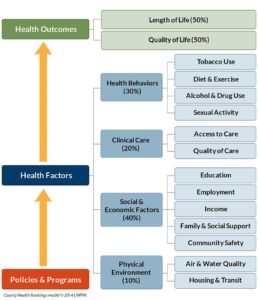Blue Cross Blue Shield of Oklahoma
Hands on elementary education campaign about the dangers of tobacco... Read more →
April 2016
When the La Crosse Medical Health Science Consortium first began considering how to improve the health of our community, one of the first tools we turned to was the health model developed by the University of Wisconsin’s Population Health Institute. With an initial goal of making our county the healthiest in the state, we looked to the model to see where we could have the most impact.
In this model, four Health Factors determine what influences health most: Clinical Care, Health Behaviors, Social & Economic Factors, and Physical Environment. In the early stages of developing a plan for a healthier county, we chose to focus specifically on Health Behaviors—diet, physical activity, tobacco use, alcohol use, etc. With so many organizations and services in our community focused on health behaviors, we worked to align the efforts of many local organizations with the goal of improving our ranking through a common health improvement plan.

Similarly, workplaces seeking to improve the health of their employees often focus on influencing the individual behaviors of each worker through incentives for developing healthier habits, smoking cessation programs, and on-site health screenings and farmers markets. All of these offer opportunities for employees to improve their own health, and thus the productivity and efficiency of their employer.
But, as the model shows, health behaviors only account for 30% of our health, and if we do not consider the impact of the remaining factors, we are not seeing the complete picture of what good health can be.
As our work at the Consortium developed, we began to look more carefully at health equity—the idea of all people having an equal opportunity for good health. It was through this lens that we came to see the value of revisiting other aspects of the health model. If we were to impact health behaviors for all individuals, we had to understand the context in which health-related decisions were made and the disparities therein.
Socioeconomic and physical environment factors, such as housing quality, access to transportation, education level, income status, and social support, together determine 50% of our health. These factors explain the conditions in which health behaviors occur. For example, the decision to eat a healthy diet can be more difficult to sustain for an individual living in a food desert. Likewise, choosing to be more physically active can be harder for someone living in an unsafe neighborhood with no recreational opportunities nearby.
Employers have an obvious and direct influence on their employees’ socioeconomic status simply by providing a job and a source of income, but their influence can also reach much more deeply. It is by impacting health at its roots that an employer seeking a healthier workforce will find some of the greatest opportunities.
Investing in the education of employees, for example, through job training, professional development, skill-building, and leadership development, can create opportunities not only for developing better job skills but also for higher levels of performance and engagement. Can partnerships with local educational institutions lead to improvement opportunities for your employees?
Access to safe, reliable transportation has a very direct impact on an employee’s productivity and level of success. What opportunities does your business have for helping employees access reliable transportation?
Many employers draw their workforce from a wide area surrounding their physical location, yet most businesses also exist within a neighborhood or community themselves. Employers that see themselves as good neighbors and who invest in the success of their neighbors—regardless of where they work—adds to the overall sense of community. A sense of belonging, or sense of community, is one of the key measures set by the Robert Wood Johnson Foundation as an important component of a community’s “Culture of Health”.
In La Crosse, Wisconsin, area employers such as Viterbo University, Mayo Clinic Health System-Franciscan Healthcare, and Gundersen Health System have directly invested in the neighborhoods immediately surrounding their campuses, providing locations for neighborhood-based social workers and community police, supporting community gardens, helping to develop neighborhood improvement plans, contributing to housing improvements, and incentivizing their employees to live in nearby neighborhoods.
Having a sense of community between an employer and its physical neighbors allows the values of the employer to be carried throughout the community, both internally and externally. This builds another important component of aspects of good health—social support. How might your organization be a better neighbor, and how might you engage your workers in supporting your local neighborhood?
Employers who consider the context of their employees’ lives—the needs of their families, their homes, and their neighborhoods—may find surprising opportunities to indirectly impact the health and well-being of their workforce.
Health is more than just a group of behaviors and choices made by individuals. It is an outcome of many factors, some of which do not seem directly linked to health. By investing in your workforce both directly, through support for healthy decision-making, and indirectly, by improving the conditions in which your workers live, work, and play, employers can play an important role in building a strong foundation for health. How will you influence your workers’ health today?

Catherine Kolkmeier is the Director of the La Crosse Medical Health Science Consortium in La Crosse, Wisconsin. The Consortium is a partnership of two major medical centers, three schools of higher education, a school district, and a county health department. It is dedicated to fostering collaboration for healthier communities by improving population health and strengthening the healthcare workforce.
If you represent a business, corporation, healthcare system or coalition engaged in community partnerships and well-being initiatives, consider sharing your story!
Comments